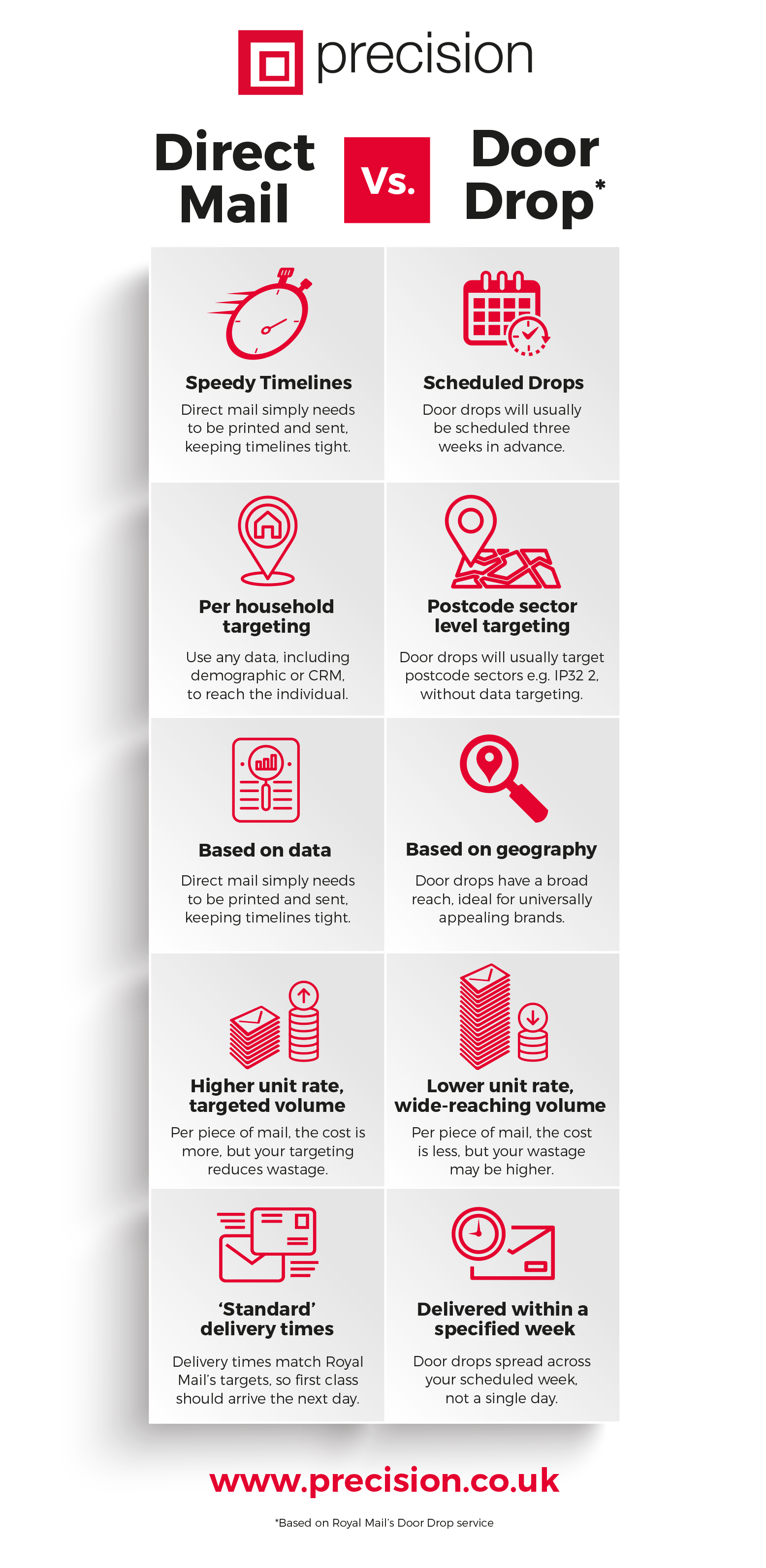Door drops vs direct mail: the power of a multichannel approach.

“Multichannel marketing gives you the power and the opportunity to mix and match how you get a message to your audience.”
by Ben Walker
When it comes to household-level marketing, mail is alive and well. Mail-based advertising has worked for 100s of years and, in a market that’s so often saturated with digital distractions, having a tangible, physical, well-designed advertisement can take the proverbial cake.
Studies show that 27% of direct mail is still “live” in the household after 28 days1. One of the benefits of mail is you can put it somewhere for later where it lives as a constant reminder, and that other members of your household might pick it up, look at it, and benefit from it.
So, we’ve established mail is great, has its benefits, and sometimes even has an edge on its younger brother, digital marketing, but what about when it comes to choosing between mail marketing services?
Do you go for a door drop or do you go for a direct mailer?
What is the difference between direct mail and a door drop?
First of all, what’s the difference between direct mail and a door drop?
The main difference is that direct mail is data driven and sent at a household level, where door drops are sent on a postcode sector level with minimal data refinements.
In other words, you can supercharge a direct mailer using your CRM or using demographic data to only send mail to those most likely to benefit from it, where with a door drop your filtering and targeting options are much more limited.
Which one suits you more might depend on your product or service. You know your audience and you know how broadly similar or different the demographics within that audience are. If they’re quite broad, a door drop might be better, but if it’s a niche product with a specific audience you can spend less and get a much better return on investment.
What is a door drop?
A door drop targets a large area of households and usually works by postcode sector (for example, it would target all households in IP33 2). You can add some limited pre-specified demographic profiling over the top of that using Mosaic profiles, but not to the same level as a direct mailer.
The unit rate is generally lower than a direct mailer but there will generally be many more units, too. Therefore, door drops are great for products and services with a wide appeal which is why you’ll get so many menu flyers from local takeaways. Everybody loves food, everybody gets a leaflet.
Royal Mail does offer a door drop service, too, helping keep costs down, but there can be a lengthy lead time of four weeks from ordering print until a distribution can start. Door drops are therefore one to make sure are in the calendar in advance unless you’re using an independent distribution team.
In all, a door drop is an inexpensive way to reach a wide geographic audience with your product or service, but, the more people you reach that won’t interact with your product, the lower your conversion rate (or “art-to-bin” ratio).
What is direct mail?
Direct mail is targeted marketing, so, instead of a banner ad calling out to the internet in general, it’d be more similar to a remarketing advertisement that already knows about how much you love shoes.
While door drops can use some data to refine who receives the delivery, the parameters are predefined in a way that they simply aren’t with direct mail. Put simply, any data can dictate who receives a direct mailer where door drops are predominantly based on geographic rules with minimal data layered in.
If you’re selling televisions, one of the best audiences for marketing will be recent home movers, first time renters, first time buyers. Door drops will reach these households, but you can set up a direct mailer to only reach these households.
If you have a CRM and want to remind a quiet 20% of your audience that they love your product, you can send a customised message to those customers. Then, you can add geographies to this and lower your costs even more by targeting the 20 people in this proximity to your store that are the most likely in the area to purchase and interact with your products.
So, while the unit rate is higher than a door drop, the pinpoint accuracy and higher conversion rates make up for this if your product has a more specific audience. Your lead times are much faster, too, with about ten days at most from purchase to delivery.
Key things to note
So, what are the key differences? First of all, your artwork may need to be a little bit different. As door drops are “dropped” onto a postcode sector, the post person doesn’t need an address where a direct mailer will either need to be placed in an envelope with an address block, or have a compliant address exclusion zone.
That being said, there is still a massive amount of creativity you can have on your postcard with the address block. If it’s Christmas, for example, you can make it look like a gift tag, and your audience might respond better to being specifically chosen for your great Spring Sale offer than they would to artwork without an address, especially if they’ve already interacted with your brand in the past.
A good way to think about it: door drops are geography-driven where direct mailers are data driven. You can layer geography into a direct mailer, too, but you’re still using data to refine that and exclude addresses that are less likely to interact with your campaign or that simply aren’t relevant.
The data you use to refine a direct mailer is up to you, you can use existing marketing technologies, such as Precision Connects, to filter down millions of household records based on key demographic factors, such as age, salary range, holiday interests, number of cars, and so on, or you can use your own data to find your perfect audience.

The importance of a data-driven marketing approach
The importance of a data-driven marketing approach is very clear: you’ll keep your marketing spend lower. It’s that simple, casting a targeted, clear, and measurable net is generally much cheaper and more effective than casting a wide net, especially if your brand has a specific target market.
Data-driven doesn’t just need to mean in terms of your targeting, however, tracking data and using it is important for your KPIs, no matter which channel you’re using. This way you can iterate, steer in different directions, and choose which channels your audience interacts with the most and drill down into why.
Knowing where your audience is coming from and how they got to your store or website or products is critical in creating high performing, high converting marketing campaigns and, thankfully it being the age of information, it’s easy to mix and match channels and collect data on each.
Which is better, direct mail or door drop?
So, which is better? As always, it depends, but, there’s no harm in filtering down your audience to those most likely to interact with your brand. If, then, filtering your data with demographics means that your net remains wide, then switch to a door drop.
It has, does, and always will come down to knowing your audience. If your audience is broad, there’s no point reaching that same audience at a higher unit rate with one or two broad demographic filters when a door drop would reach an extra ten or twenty households, if your audience is Fred from Newmarket then don’t door drop every household in Fred’s postcode sector.
Therefore, it’s not so much about “better” as it is about suitability. Which is more suitable for this product, service, or campaign? Well, this campaign has a wider reach so let’s go for a door drop where that one is way more specific so let’s filter down our audience more.
It’s all about being strategic and getting the most value out of each communication your company puts out, and making it much more likely that that message will reach your perfect audience.
The metrics themselves are comparable, with 92% of study respondents saying they’ve gone online from receiving mail2 showing the success of either channel, however, how successful a direct mail campaign is compared to a door drop will depend on the campaign’s target audience and goals rather than solely on the channel.
The power of a multichannel approach
When it comes to multichannel, where is the value in switching channels? It’s easy to think that multichannel is only about getting your audience to see your brand and message as many times as possible, and that can be a part of it, but another great strategy is using channels to refine an audience, working up to mediums with higher unit rates.
So long as your artwork has clear CTAs and a place to go and you can measure audience’s data, you’ll be able to interact with a subset of your original cohort and filter out individuals who quite simply haven’t interacted with your brand.
With smart data capabilities, you’ll be able to retarget the same audience with offers, incentives, and communications via multiple different channels and see which the most effective are with your target market, then apply your learnings to a larger audience.
Multichannel marketing gives you the power and the opportunity to mix and match how you get a message to your audience, and measure how successful each channel is while keeping your costs and campaign wastage to a minimum.
Find out more about how you can leverage direct mail, door drops, and digital channels to get your brand’s message to your perfect audience on time and under budget with Precision. Contact the team at getintouch@precision.co.uk today.
Get in touch with us and
let's start a conversation
Precision
Precision House
Lamdin Road
Bury St Edmunds
IP32 6NU
T: 01284 718900
